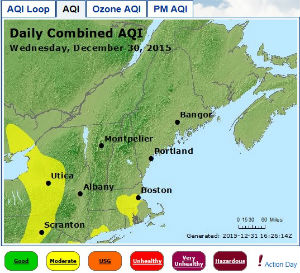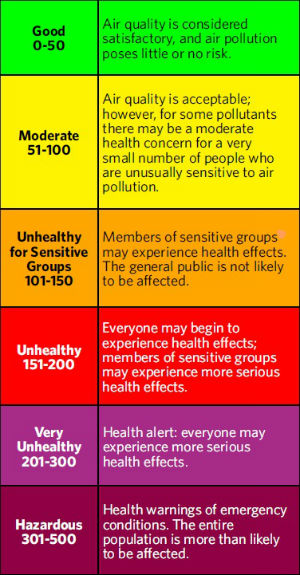 To minimize potential health impacts from open burning, we recommend utilizing air quality forecasts when planning the burn. Depending on the meteorological conditions, the proximity of the burn to residences, and air quality level on the day of the burn, smoke from open burning may cause health problems such as respiratory effects or aggravation of heart and lung diseases.
To minimize potential health impacts from open burning, we recommend utilizing air quality forecasts when planning the burn. Depending on the meteorological conditions, the proximity of the burn to residences, and air quality level on the day of the burn, smoke from open burning may cause health problems such as respiratory effects or aggravation of heart and lung diseases.
The Vermont Air Quality and Climate Division works with other states and the US EPA to provide daily forecasts of the next day’s air quality for two major air pollutants: ozone (O3) and fine particles (PM2.5). The forecasts for PM2.5 may be useful for town managers, fire wardens and others who issue open burning permits, as smoke from open burning activities can produce high localized concentrations of PM2.5 pollution in situations where air stagnation occurs.
localized concentrations of PM2.5 pollution in situations where air stagnation occurs.
The forecasts, as well as current measured air quality levels in Vermont and other states are available at http://airnow.gov. Click Vermont on the national map for forecasts and data for Vermont locations. The PM2.5 levels are reported according to an Air Quality Index (AQI), which ranges from 0 to 500 numerically. In Vermont, PM2.5 levels are typically good to moderate, but occasionally climb into the unhealthy range.
Individuals interested in air quality conditions may also sign up for automatic e-mail or cell phone text message forecast notifications, using EPA’s EnviroFlash service: http://www.enviroflash.info. Note that you can request to receive EnviroFlash messages only if the forecast or current air quality exceeds a certain level – for example moderate or higher. In both AirNow and EnviroFlash, there is an option to see forecasts for “Vermont Mountain Valley Locations”. Forecasts for these locations are based on meteorological estimates of poor dispersion conditions, which can occur during calm, clear mornings, evenings and overnight during the “cold season” (approximately October 15 through March 1). Cold season forecasts for these mountain valley locations are the best indicators of poor dispersion conditions for smoke from open burning activities in valley locations throughout Vermont.
The Vermont Air Quality and Climate Division offers the following (non-mandatory) recommendations for minimizing the potential health impacts of open burning activities that may impact residences during the cold season based on the PM2.5 AQI forecasts for Vermont mountain valley locations:
- If the forecast is for good levels of PM2.5, this suggests that an open burn will not result in significant air pollution impacts in the neighborhood. Note, however, that if the wind is forecast to blow from the burn location directly towards a nearby residence, the burn may still produce air pollution problems; but smoke won’t tend to accumulate over time in the neighborhood.
- If the forecast is for moderate levels of PM2.5, this suggests that an open burn may result in significant air pollution impacts in the neighborhood and an open burn is not recommended except during the daytime from 2 hours after sunrise until 1 hour before sunset when the skies are generally clear to partly cloudy.
- If the forecast is for unhealthy for sensitive groups levels of PM2.5 or higher, this suggests that an open burn will result in significant air pollution impacts in the neighborhood both because of the meteorological conditions and the likelihood that other nearby emissions will cause poor air quality, and an open burn is not recommended under these conditions.
During the cold season (approximately October 15 to March 1) an open burn is recommended during the daytime from 2 hours after sunrise until 1 hour before sunset when the skies are generally clear to partly  cloudy. During the warm season (March 1 through October 15), the atmospheric dispersion is generally much greater; however, regional air pollution occurring in a stagnant air mass over New England will occasionally reach high enough levels that it may constitute an air quality concern when combined with a local source, such as an open burn. An AQI value exceeding 75 is indicative of this kind of warm season event. Therefore no open burning that may impact residences is recommended when the warm season PM2.5 AQI value at the Vermont location nearest you exceeds 75 in the air quality forecast.
cloudy. During the warm season (March 1 through October 15), the atmospheric dispersion is generally much greater; however, regional air pollution occurring in a stagnant air mass over New England will occasionally reach high enough levels that it may constitute an air quality concern when combined with a local source, such as an open burn. An AQI value exceeding 75 is indicative of this kind of warm season event. Therefore no open burning that may impact residences is recommended when the warm season PM2.5 AQI value at the Vermont location nearest you exceeds 75 in the air quality forecast.
If you have questions about the air quality in your area on any day, feel free to call Dan Riley at (802) 272-3695 or email dan.riley@vermont.gov. Also, please call with any questions about the EnviroFlash Air quality forecast message system or other questions about air pollutant dispersion.
